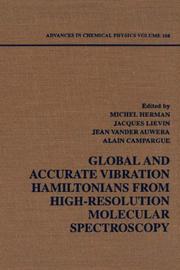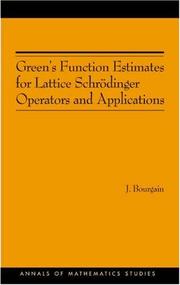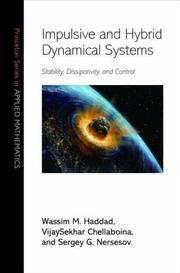| Listing 1 - 4 of 4 |
Sort by
|

ISBN: 047132843X Year: 1999 Volume: 108 Publisher: New York, NY : Wiley-Interscience,
Abstract | Keywords | Export | Availability | Bookmark
 Loading...
Loading...Choose an application
- Reference Manager
- EndNote
- RefWorks (Direct export to RefWorks)
Hamiltonian operator --- Hamiltonoperator --- High resolution spectroscopy --- Hindered rotation theory --- Hoge resolutie spectroscopie --- Internal rotation (Molecular) --- Moleculaire rotatie --- Moleculaire spectroscopie --- Molecular rotation --- Molecular spectroscopy --- Operateur hamiltonien --- Operator [Hamilton] --- Operator [Hamiltonian ] --- Rotation moléculaire --- Rotation spectra --- Spectre de vibration --- Spectroscopie [Moleculaire ] --- Spectroscopie de haute résolution --- Spectroscopie moléculaire --- Spectroscopy [High resolution ] --- Spectroscopy [Molecular ] --- Spectrum [Vibrational ] --- Trillend spectrum --- Vibration spectra --- Vibrational spectra --- Hamiltonian system --- Spectroscopie à haute résolution --- Spectroscopie moléculaire --- Spectroscopie à haute résolution

ISBN: 0691120978 1322075719 1400837146 0691120986 9780691120980 9781400837144 9780691120973 9781322075716 Year: 2004 Publisher: Princeton, NJ
Abstract | Keywords | Export | Availability | Bookmark
 Loading...
Loading...Choose an application
- Reference Manager
- EndNote
- RefWorks (Direct export to RefWorks)
This book presents an overview of recent developments in the area of localization for quasi-periodic lattice Schrödinger operators and the theory of quasi-periodicity in Hamiltonian evolution equations. The physical motivation of these models extends back to the works of Rudolph Peierls and Douglas R. Hofstadter, and the models themselves have been a focus of mathematical research for two decades. Jean Bourgain here sets forth the results and techniques that have been discovered in the last few years. He puts special emphasis on so-called "non-perturbative" methods and the important role of subharmonic function theory and semi-algebraic set methods. He describes various applications to the theory of differential equations and dynamical systems, in particular to the quantum kicked rotor and KAM theory for nonlinear Hamiltonian evolution equations. Intended primarily for graduate students and researchers in the general area of dynamical systems and mathematical physics, the book provides a coherent account of a large body of work that is presently scattered in the literature. It does so in a refreshingly contained manner that seeks to convey the present technological "state of the art."
Schrödinger operator. --- Green's functions. --- Hamiltonian systems. --- Evolution equations. --- Evolutionary equations --- Equations, Evolution --- Equations of evolution --- Hamiltonian dynamical systems --- Systems, Hamiltonian --- Functions, Green's --- Functions, Induction --- Functions, Source --- Green functions --- Induction functions --- Source functions --- Operator, Schrödinger --- Differential equations --- Differentiable dynamical systems --- Potential theory (Mathematics) --- Differential operators --- Quantum theory --- Schrödinger equation --- Almost Mathieu operator. --- Analytic function. --- Anderson localization. --- Betti number. --- Cartan's theorem. --- Chaos theory. --- Density of states. --- Dimension (vector space). --- Diophantine equation. --- Dynamical system. --- Equation. --- Existential quantification. --- Fundamental matrix (linear differential equation). --- Green's function. --- Hamiltonian system. --- Hermitian adjoint. --- Infimum and supremum. --- Iterative method. --- Jacobi operator. --- Linear equation. --- Linear map. --- Linearization. --- Monodromy matrix. --- Non-perturbative. --- Nonlinear system. --- Normal mode. --- Parameter space. --- Parameter. --- Parametrization. --- Partial differential equation. --- Periodic boundary conditions. --- Phase space. --- Phase transition. --- Polynomial. --- Renormalization. --- Self-adjoint. --- Semialgebraic set. --- Special case. --- Statistical significance. --- Subharmonic function. --- Summation. --- Theorem. --- Theory. --- Transfer matrix. --- Transversality (mathematics). --- Trigonometric functions. --- Trigonometric polynomial. --- Uniformization theorem.
Book
ISBN: 3039214101 3039214098 Year: 2019 Publisher: MDPI - Multidisciplinary Digital Publishing Institute
Abstract | Keywords | Export | Availability | Bookmark
 Loading...
Loading...Choose an application
- Reference Manager
- EndNote
- RefWorks (Direct export to RefWorks)
The use of machine learning in mechanics is booming. Algorithms inspired by developments in the field of artificial intelligence today cover increasingly varied fields of application. This book illustrates recent results on coupling machine learning with computational mechanics, particularly for the construction of surrogate models or reduced order models. The articles contained in this compilation were presented at the EUROMECH Colloquium 597, « Reduced Order Modeling in Mechanics of Materials », held in Bad Herrenalb, Germany, from August 28th to August 31th 2018. In this book, Artificial Neural Networks are coupled to physics-based models. The tensor format of simulation data is exploited in surrogate models or for data pruning. Various reduced order models are proposed via machine learning strategies applied to simulation data. Since reduced order models have specific approximation errors, error estimators are also proposed in this book. The proposed numerical examples are very close to engineering problems. The reader would find this book to be a useful reference in identifying progress in machine learning and reduced order modeling for computational mechanics.
supervised machine learning --- proper orthogonal decomposition (POD) --- PGD compression --- stabilization --- nonlinear reduced order model --- gappy POD --- symplectic model order reduction --- neural network --- snapshot proper orthogonal decomposition --- 3D reconstruction --- microstructure property linkage --- nonlinear material behaviour --- proper orthogonal decomposition --- reduced basis --- ECSW --- geometric nonlinearity --- POD --- model order reduction --- elasto-viscoplasticity --- sampling --- surrogate modeling --- model reduction --- enhanced POD --- archive --- modal analysis --- low-rank approximation --- computational homogenization --- artificial neural networks --- unsupervised machine learning --- large strain --- reduced-order model --- proper generalised decomposition (PGD) --- a priori enrichment --- elastoviscoplastic behavior --- error indicator --- computational homogenisation --- empirical cubature method --- nonlinear structural mechanics --- reduced integration domain --- model order reduction (MOR) --- structure preservation of symplecticity --- heterogeneous data --- reduced order modeling (ROM) --- parameter-dependent model --- data science --- Hencky strain --- dynamic extrapolation --- tensor-train decomposition --- hyper-reduction --- empirical cubature --- randomised SVD --- machine learning --- inverse problem plasticity --- proper symplectic decomposition (PSD) --- finite deformation --- Hamiltonian system --- DEIM --- GNAT

ISBN: 1400865247 9781400865246 9780691127156 0691127158 Year: 2006 Publisher: Princeton, New Jersey Oxfordshire, England
Abstract | Keywords | Export | Availability | Bookmark
 Loading...
Loading...Choose an application
- Reference Manager
- EndNote
- RefWorks (Direct export to RefWorks)
This book develops a general analysis and synthesis framework for impulsive and hybrid dynamical systems. Such a framework is imperative for modern complex engineering systems that involve interacting continuous-time and discrete-time dynamics with multiple modes of operation that place stringent demands on controller design and require implementation of increasing complexity--whether advanced high-performance tactical fighter aircraft and space vehicles, variable-cycle gas turbine engines, or air and ground transportation systems. Impulsive and Hybrid Dynamical Systems goes beyond similar treatments by developing invariant set stability theorems, partial stability, Lagrange stability, boundedness, ultimate boundedness, dissipativity theory, vector dissipativity theory, energy-based hybrid control, optimal control, disturbance rejection control, and robust control for nonlinear impulsive and hybrid dynamical systems. A major contribution to mathematical system theory and control system theory, this book is written from a system-theoretic point of view with the highest standards of exposition and rigor. It is intended for graduate students, researchers, and practitioners of engineering and applied mathematics as well as computer scientists, physicists, and other scientists who seek a fundamental understanding of the rich dynamical behavior of impulsive and hybrid dynamical systems.
Automatic control. --- Control theory. --- Dynamics. --- Discrete-time systems. --- Dynamical systems --- Kinetics --- Mathematics --- Mechanics, Analytic --- Force and energy --- Mechanics --- Physics --- Statics --- Dynamics --- Machine theory --- Control engineering --- Control equipment --- Control theory --- Engineering instruments --- Automation --- Programmable controllers --- DES (System analysis) --- Discrete event systems --- Sampled-data systems --- Digital control systems --- Discrete mathematics --- System analysis --- Linear time invariant systems --- Actuator. --- Adaptive control. --- Algorithm. --- Amplitude. --- Analog computer. --- Arbitrarily large. --- Asymptote. --- Asymptotic analysis. --- Axiom. --- Balance equation. --- Bode plot. --- Boundedness. --- Calculation. --- Center of mass (relativistic). --- Coefficient of restitution. --- Continuous function. --- Convex set. --- Differentiable function. --- Differential equation. --- Dissipation. --- Dissipative system. --- Dynamical system. --- Dynamical systems theory. --- Energy. --- Equations of motion. --- Equilibrium point. --- Escapement. --- Euler–Lagrange equation. --- Exponential stability. --- Forms of energy. --- Hamiltonian mechanics. --- Hamiltonian system. --- Hermitian matrix. --- Hooke's law. --- Hybrid system. --- Identity matrix. --- Inequality (mathematics). --- Infimum and supremum. --- Initial condition. --- Instability. --- Interconnection. --- Invariance theorem. --- Isolated system. --- Iterative method. --- Jacobian matrix and determinant. --- Lagrangian (field theory). --- Lagrangian system. --- Lagrangian. --- Likelihood-ratio test. --- Limit cycle. --- Limit set. --- Linear function. --- Linearization. --- Lipschitz continuity. --- Lyapunov function. --- Lyapunov stability. --- Mass balance. --- Mathematical optimization. --- Melting. --- Mixture. --- Moment of inertia. --- Momentum. --- Monotonic function. --- Negative feedback. --- Nonlinear programming. --- Nonlinear system. --- Nonnegative matrix. --- Optimal control. --- Ordinary differential equation. --- Orthant. --- Parameter. --- Partial differential equation. --- Passive dynamics. --- Poincaré conjecture. --- Potential energy. --- Proof mass. --- Quantity. --- Rate function. --- Requirement. --- Robust control. --- Second law of thermodynamics. --- Semi-infinite. --- Small-gain theorem. --- Special case. --- Spectral radius. --- Stability theory. --- State space. --- Stiffness. --- Supply (economics). --- Telecommunication. --- Theorem. --- Transpose. --- Uncertainty. --- Uniform boundedness. --- Uniqueness. --- Vector field. --- Vibration. --- Zeroth (software). --- Zeroth law of thermodynamics.
| Listing 1 - 4 of 4 |
Sort by
|

 Search
Search Feedback
Feedback About UniCat
About UniCat  Help
Help News
News